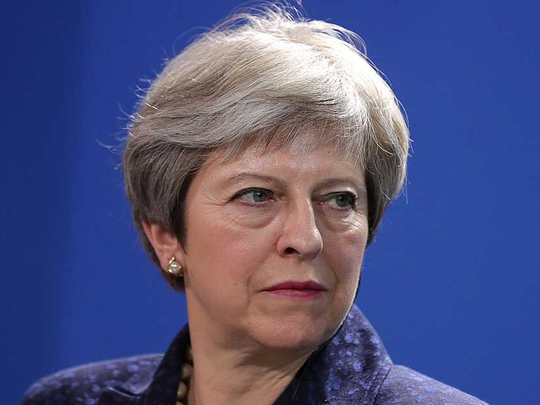
In trying to hold on to power, British Prime Minister Theresa May will have to reimpose a hard border on Ireland. That makes a “no deal” Brexit increasingly likely. It is not inevitable that Britain will crash out of the European Union (EU) without any sort of deal. But with negotiations again in crisis, it is currently headed that way. Politically unable to avoid a hard border in Ireland, and unable to strike a deal with Europe while imposing one, May’s government finds itself incapable of holding on to office if it follows any other course.
There are, broadly, three ways to avoid the return of customs checks and stations to the long-troubled Irish border: A united Ireland, the kind of special arrangement for Northern Ireland outlined in the European Commission’s draft agreement published recently, or a settlement covering the whole United Kingdom involving something similar to the existing customs union and probably some sort of commitment to regulatory alignment.
None of these options are open to May.
The Good Friday agreement requires the secretary of state to trigger a border poll if it appears likely that a majority in Northern Ireland would vote to join the Republic of Ireland. At present, the evidence is mixed. As recently as December the polling company Lucid Talk found that, faced with a “hard Brexit”, 48 per cent would vote for a united Ireland and to remain inside the EU, while only 45 per cent preferred to stick with the UK and leave. In reality, no Tory leader could sell a united Ireland to her party or survive it happening on her watch. Long before a poll was called, the government’s arrangement with the Democratic Unionist Party (DUP) would have crumbled.
In theory, there should be no obstacle to the EU’s present proposal to include Northern Ireland in a “common area”. Taken in isolation, the DUP’s opposition does not afford it a right of veto any more than Sinn Fein, or even the province’s pro-remain electorate, has the right to veto Brexit itself. Northern Ireland already has laws — controversially in the case of equal marriage, abortion and language rights — that differ markedly from those in Britain. Certain imports from the larger island — animals and animal products, for instance — are already controlled to protect the local industry from contagion, and anyone flying from Belfast to London or Glasgow is required to show identification, usually in the form of a passport.
But, as all of Europe saw when Arlene Foster hauled the prime minister out of her lunch with Jean-Claude Juncker late last year, the hard-Brexit DUP has set its face against what it sees as a border in the Irish Sea, and May lacks the votes in parliament to go against that party’s wishes. Even if May were to support a customs union — or anything remotely like it — the prospect remains entirely unacceptable to the Tory right, as a menacing letter from Jacob Rees-Mogg and friends in the European Research Group highlighted just last week.
A prisoner of her party, the DUP and her own hubris, for May to stay in office she has to reimpose a hard border.
The Irish, and Anglo-Irish, implications of this slow-motion car crash are increasingly well rehearsed. Brexit Secretary Boris Johnson attracted ridicule last Tuesday for suggesting the invisible boundary between the London boroughs Camden and Westminster as a possible model for a post-Brexit border. But he did inadvertently highlight how partition was experienced and what a hard Brexit might mean.
The county boundaries on which the border is based had once been no more visible than those between boroughs today. The border cuts through farms, villages and communities as well as local economies that in 20 peaceful years have once again grown intertwined. An estimated 30,000 people cross the frontier every day for work, as effortlessly as those who travel into Camden on the bus.
As one clergyman from Drummully, a part of County Monaghan still completely inaccessible by road except through Northern Ireland, told the Irish boundary commission in 1925: “We never thought about the difference between one county and another before that change was made.”
The return of a customs barrier will clearly not demand the return of 30-year-old technology, much as at airports we increasingly scan our passports rather than have them stamped by hand. But policing any smuggling trade — likely to be driven by renewed economic isolation as a result of Brexit — will still require people to open car boots and the backs of lorries.
For much of the 20th century the borderlands bore witness to the very violence of which partition is a product. Border posts were blown up in the 1920s, burnt down in the 1930s, and destroyed at regular intervals until they were eventually made redundant by economic integration. Reinstated customs installations, whether staffed or electronic, will in all likelihood require protection and potentially pose a long-term threat to peace.
Under different circumstances matters such as these might have been expected to evoke at best hand-wringing and much shoulder-shrugging from a British public and political class happy to leave “the Irish question” in the past. But failure to prevent the return of a hard border in Ireland will mean reneging on the very first agreement struck between Britain and the European Commission. It is almost insulting to expect the remaining EU member-states to be willing to reach agreement on transitional or permanent arrangements in such circumstances. Without a change of government the prospects for any kind of deal with the EU are surely bleak.
— Guardian News & Media Ltd
Peter Leary is a junior research fellow at the Institute of Advanced Studies, University College London. He is the author of Unapproved Routes: Histories of the Irish Border, 1922-72.










